
Gamma Eridani, formally named Zaurak, is a variable star in the constellation of Eridanus. It is visible to the naked eye with an apparent visual magnitude that varies around 2.9, and lies at a distance of about 203 light years from the Sun, as determined by the Hipparcos astrometry satellite.

ν Virginis, Latinized as Nu Virginis, is a single star in the zodiac constellation of Virgo, located at the western tip of the classic constellation and nearly due south of the prominent star Denebola. It is a red-hued star with an apparent visual magnitude of 4.04 and can be seen with the naked eye. Because the star lies near the ecliptic it is subject to occultations by the Moon. Parallax measurements provide an estimated distance of around 331 light years from the Sun, and it is drifting further away with a radial velocity of +50 km/s.

Omega Virginis is a solitary star in the zodiac constellation Virgo. It has an apparent visual magnitude of +5.2, which is bright enough to be faintly visible to the naked eye. Based upon an annual stellar parallax shift of 6.56 milliarcseconds, it is located about 500 light years from the Sun.

9 Aurigae is a star system in Auriga (constellation). It has an apparent magnitude of about 5, making it visible to the naked eye in many suburban skies. Parallax estimates made by the Hipparcos spacecraft put it at about 86 light-years from the solar system, although individual Gaia Data Release 3 parallaxes place all three components at 88 light years.
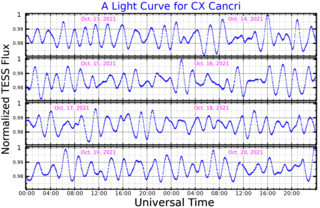
28 Cancri is a star system in the zodiac constellation of Cancer. It is a variable star with the designation CX Cancri, and is close to the lower limit of visibility with the naked eye, having a mean apparent visual magnitude of 6.05. The annual parallax shift seen from Earth's orbit is 8.5 mas, which provides a distance estimate of about 384 light years. It is moving away from the Sun with a radial velocity of around +9 km/s.
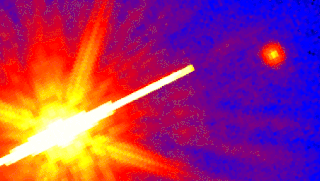
Gliese 105 is a triple star system in the constellation of Cetus. It is located relatively near the Sun at a distance of 23.6 light-years. Despite this, even the brightest component is barely visible with the unaided eye (see Bortle scale). No planets have yet been detected around any of the stars in this system.
Gliese 412 is a pair of stars that share a common proper motion through space and are thought to form a binary star system. The pair have an angular separation of 31.4″ at a position angle of 126.1°. They are located 15.8 light-years distant from the Sun in the constellation Ursa Major. Both components are relatively dim red dwarf stars.
HD 36678 is single star in the northern constellation of Auriga. This star is dimly visible to the naked eye with an apparent visual magnitude of 5.83. It is located at a distance of approximately 840 light years from the Sun based on parallax.
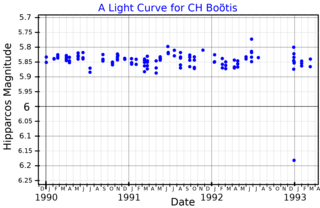
HD 128333 or CH Boötis is an irregular variable star in the northern constellation of Boötes. It is currently on the asymptotic giant branch of the HR diagram.
HD 30442 is a solitary star in the northern circumpolar constellation Camelopardalis. It is faintly visible to the naked eye with an apparent magnitude of 5.47 and is estimated to be 403 light years away from the Solar System. The object has a heliocentric radial velocity of −37 km/s, indicating that it is drifting closer.
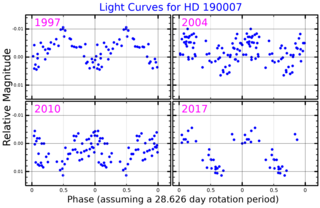
HD 190007, also known as Gliese 775, is a star with a close orbiting exoplanet in the constellation of Aquila. Parallax measurements by Gaia put the star at a distance of 41.5 light-years away from the Sun. It is drifting closer with a radial velocity of −30.3 km/s, and is predicted to come within 11.8 light-years in 375,000 years. The star has an absolute magnitude of 6.91, but at its present distance the apparent visual magnitude is 7.46, which is too faint to be viewed with the naked eye.
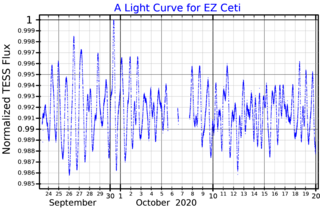
Chi Ceti , is the Bayer designation for a double star in the equatorial constellation of Cetus. They appear to be common proper motion companions, sharing a similar motion through space. The brighter component, HD 11171, is visible to the naked eye with an apparent visual magnitude of 4.66, while the fainter companion, HD 11131, is magnitude 6.75. Both lie at roughly the same distance, with the brighter component lying at an estimated distance of 75.6 light years from the Sun based upon an annual parallax shift of 43.13 mass.
Phi2 Ceti, Latinized from φ2 Ceti), is a star located in the equatorial constellation of Cetus. φ2 Ceti is also known as 19 Cet, and HD 4813. Based upon parallax measurements, it is located about 51 light years away. It has an apparent visual magnitude of +5.19, making it bright enough to be seen with the naked eye. The star is drifting further away with a radial velocity of +8 km/s.

Omega1 Cygni, Latinized from ω1 Cygni, is the Bayer designation for a solitary star in the northern constellation of Cygnus. It is visible to the naked eye with an apparent visual magnitude of 4.94. Based upon an annual parallax shift of 2.59 mas, it is estimated to lie roughly 1,260 light years from the Sun. Relative to its neighbors, this star has a peculiar velocity of 25.7±2.2 km/s.
HD 102350 is a single star in the constellation Centaurus. It has a yellow hue and is visible to the naked eye with an apparent visual magnitude of 4.11. The distance to this star is approximately 390 light years based on parallax, but it is drifting closer with a radial velocity of −3 km/s. It has an absolute magnitude of −1.51.
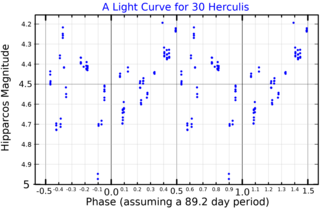
g Herculis is a binary star system in the northern constellation of Hercules. It has the Flamsteed designation 30 Herculis, while g Herculis is the Bayer designation. This system is visible to the naked eye as a faint, red-hued point of light. Based upon a measured parallax of 9.2 mas, it is located around 354 light years away from the Sun. The system is moving further from the Earth with a heliocentric radial velocity of 1.5 km/s.
Pi Leonis, Latinised from π Leonis, is a single star in the zodiac constellation Leo. It is a red-hued star that is visible to the naked eye with an apparent visual magnitude of 4.70. This object is located at a distance of some 410 light-years from the Sun based on parallax, and is drifting further away with a radial velocity of +22 km/s. Because the star lies near the ecliptic it is subject to occultations by the Moon.
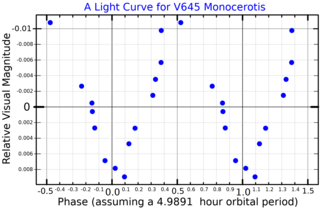
28 Monocerotis is a single star in the equatorial constellation of Monoceros. It has an orange-hue and is faintly visible to the naked eye with an apparent visual magnitude of 4.69. The distance to this star is approximately 450 light years based on parallax, and it has an absolute magnitude of −1.00. The star is drifting further away from the Sun with a radial velocity of +26.7 km/s.
90 Tauri is a star in the zodiac constellation of Taurus, located 144 light-years away from the Sun. It is visible to the naked eye as a faint, white-hued star with an apparent visual magnitude of 4.27. 90 Tauri is a member of the Hyades cluster and is listed as a double star.

32 Tauri is the Flamsteed designation for a solitary star in the zodiac constellation of Taurus. It has a visual magnitude of 5.64, making it visible to the naked eye from suburban skies. The position of this star near the ecliptic plane means that it is subject to occultations by the Moon. Parallax measurements put it at a distance of 144 light years from the Sun. It is drifting further away with a radial velocity of +31.9 km/s, having come to within 88.9 light-years some 759,000 years ago.












